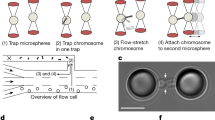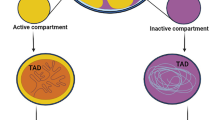Abstract
The development of procedures for the isolation of unfixed metaphase chromosomes has made feasible a direct analysis of their morphology. Wholemount stereo electron microscopy was used to examine intact and partially disrupted chromosomes produced by physical shearing and extraction with salt and urea solutions. A model of chromosome architecture was developed to accommodate evidence from studies using both light and electron microscopy. In the proposed model the chromatid (anaphase chromosome) consists of two half-chromatids; each half-chromatid contains two deoxyribonucleoprotein ribbons wound into a single fiber (termed the core), with many loops of chromatin (termed epichromatin) attached along its length. The core ribbons are each about 50 Å thick by 4000 Å wide and are composed of many parallel deoxyribonucleoprotein strands. The epichromatin loops appear to be 250 Å supercoiled fibers containing about 75 per cent of the chromosomal DNA. The epichromatin can be selectively removed from the core fibers by extraction with 2.0 M NaCl or 6.0 M urea solutions.
Similar content being viewed by others
Explore related subjects
Discover the latest articles and news from researchers in related subjects, suggested using machine learning.References
Abuelo, J. G., Moore, D. E.: The human chromosome. Electron microscope observations on chromatin fiber organization. J. Cell Biol. 41, 73–90 (1969).
Anderson, T. F.: Techniques of preservation of three dimensional structure in preparing specimens for the electron microscope. Trans. N. Y. Acad. Sci. II 13, 130–134 (1951).
Bajer, A.: Subchromatid structure of chromosomes in the living state. Chromosoma (Berl.) 17, 291–302 (1965).
Brewen, J. G., Peacock, W. J.: Restricted rejoining of chromosomal subunits in aberration formation: a test for subunit dissimilarity. Proc. nat. Aead. Sci. (Wash.) 62, 389–394 (1969).
Brinkley, B. R., Shaw, M. W.: Ultrastructural aspects of chromosome damage. In: Genetic concepts and neoplasia, 23rd Annual Symposium on Fundamental Cancer Research, The University of Texas M. D. Anderson Hospital and Tumor Institute at Houston, p. 313–345. Baltimore: The Williams and Wilkins Co. 1970.
—, Stubblefield, E.: The fine structure of the kinetochore of a mammalian cell in vitro. Chromosoma (Berl.) 19, 28–43 (1966).
—: Ultrastructure and interaction of the kinetochore and centriole in mitosis and meiosis. Advanc. Cell Biol. 1, 119–185 (1970).
Britten, R. J., Kohne, D. E.: Repeated sequences in DNA. Science 161, 529–540 (1968).
Brooke, J. H., Jenkins, D. P., Lawson, R. K., Osgood, E. E.: Human chromosome uncoiling and dissociation. Ann. Human Genet. (Lond.) 26, 139–143 (1962).
Callan, H. G.: The nature of lampbrush chromosomes. Int. Rev. Cytol. 15, 1–34 (1963).
—: The organization of genetic units in chromosomes. J. Cell Sci. 2, 1–7 (1967).
—, Lloyd, L.: Lampbrush chromosomes of crested newts Triturus cristatus (Laurenti). Phil. Trans. B 243, 135–219 (1960).
Cole, A.: The structure of chromosomes. In: Theoretical and experimental biophysics (A. Cole, ed.), p. 305–375. London: E. Arnold Ltd. 1967.
Comings, D. E.: The rationale for an ordered arrangement of chromatin in the interphase nucleus. Amer. J. human Genet. 20, 440–460 (1968).
Darlington, C. D.: Recent advances in cytology, 2nd ed., p. 671 Philadelphia: Blakiston 1937.
Deaven, L. L.: Segregation of chromosomal DNA in Chinese hamster fibroblasts. J. Cell Biol. 39, 32a (1968).
—, Stubblefield, E.: Segregation of chromosomal DNA in Chinese hamster fibroblasts in vitro. Exp. Cell Res. 55, 132–135 (1969).
DuPraw, E. J.: Macromolecular organization of nuclei and chromosomes: A “foldedfiber” model based on whole mount electron microscopy. Nature (Lond.) 206, 338–343 (1965a).
—: The organization of nuclei and chromosomes in honeybee embryonic cells. Proc. nat. Acad. Sci. (Wash.) 53, 161–168 (1965b).
Frederic, J.: Mise en évidence de structures internes des chromosomes par une technique nouvelle (scanning video). Chromosoma (Berl.) 28, 199–210 (1969).
Gall, J. G.: Kinetics of deoxyribonuclease action on chromosomes. Nature (Lond.) 198, 36–38 (1963a).
—: Chromosome fibers from an interphase nucleus. Science 139, 120–121 (1963b).
—, Callan, H. G.: H3-uridine incorporation in lampbrush chromosomes. Proc. nat. Acad. Sci. (Wash.) 48, 562–570 (1962).
Heddle, J. A., Bodycote, D. J.: The strandedness of chromosomes. J. Cell Biol. 39, 60a (1968).
Hsu, T. C., Zenzes, M. T.: Mammalian chromosomes in vitro. XVII. Idiogram of the Chinese hamster. J. nat. Cancer Inst. 32, 857–869 (1964).
Jones, K. W.: Chromosomal and nuclear location of mouse satellite DNA in individual cells. Nature (Lond.) 225, 912–915 (1970).
Kaufmann, B. P.: Chromosome structure and its relation to the chromosomal cycle. I. Somatic mitoses in Tradescantia pilosa. Amer. J. Bot. 13, 59–80 (1926).
Maio, J. J., Schildkraut, C. L.: Isolated mammalian metaphase chromosomes. II. Fractionated chromosomes of mouse and Chinese hamster cells. J. molec. Biol. 40, 203–216 (1969).
Makino, S.: The spiral structure of chromosomes in the meiotic division of Podisma (Orthoptera). J. Fac. Sci. Hokkaido Imp. Univ., Ser. VI 3, 29–40 (1936).
Manton, I.: The spiral structure of chromosomes. Biol. Rev. 25, 486–508 (1950).
Marin, G., Prescott, D. M.: The frequency of sister chromatid exchanges following exposure to varying doses of H3-thymidine or X-rays. J. Cell Biol. 21, 159–167 (1964).
Miller, O. L.: Fine structure of lampbrush chromosomes. Nat. Cancer Inst. Monogr. 18, 79–99 (1965).
Moens, P. B.: The structure and function of the synaptinemal complex in Lilium longiflorum sporocytes. Chromosoma (Berl.) 23, 418–451 (1968).
Moses, M. J.: Synaptinemal complex. Ann. Rev. Genet. 2, 363–412 (1968).
Nebel, B. R.: Chromosome structure in Tradescantiae. I. Methods and morphology. Z. Zellforsch. 16, 251–284 (1932).
Ohnuki, Y.: Structure of chromosomes. I. Morphological studies of the spiral structure of human somatic chromosomes. Chromosoma (Berl.) 25, 402–428 (1968).
Pardue, M. L., Gall, J. G.: Chromosomal localization of mouse satellite DNA. Science 168, 1356–1358 (1970).
Peacock, W. J.: Chromosome duplication and structure as determined by autoradiography. Proc. nat. Acad. Sci. (Wash.) 49, 793–801 (1963).
Person, C., Suzuki, D. T.: Chromosome structure—a model based on DNA replication. Canad. J. Genet. Cytol. 10, 627–647 (1968).
Prescott, D. M.: The structure and replication of eukaryotic chromosomes. Advanc. Cell Biol. 1, 57–117 (1970).
Ray-Chaudhuri, S. P., Kakati, S., Sharma, T.: Split and enlarged satellites in man. Heredity 23, 146–149 (1968).
Ris, H.: Ultrastructure and molecular organization of genetic systems. Canad. J. Genet. Cytol. 3, 95–120 (1961).
- Effect of fixation on the dimension of nucleohistone fibers. J. Cell Biol. 39, 158a (1968).
Sorsa, V., Pusa, K., Virrankoski, V., Sorsa, M.: Electron microscopy of an induced “lampbrush stage” of the polytene chromosome. Exp. Cell Res. 60, 466–469 (1970).
Sparvoli, E., Gay, H., Kaufmann, B. P.: Distribution of incorporated H3-thymidine in mitotic chromosomes of Haplopappus gracilis. Abstr. Intern. Congr. Radiation Res., 3rd, Cortina d'Ampezzo, Italy, p. 208 1966.
Steffensen, D.: Chromosome structure with special reference to the role of metal ions. Int. Rev. Cytol. 12, 163–197 (1961).
Stockert, J. C.: Half-chromatids in the human chromosomes from leucocyte cultures. Cytologia (Tokyo) 34, 160–162 (1969).
Stubblefield, E.: Mammalian chromosomes in vitro. XIX. Chromosomes of Don-C, a Chinese hamster fibroblast strain with a part of autosome 1 b translocated to the Y chromosome. J. nat. Cancer Inst. 37, 799–817 (1966).
—: Synchronization methods for mammalian cell cultures. Methods in Cell Physiol. 3, 25–43 (1968).
Taylor, J. H.: The time and mode of duplication of chromosomes. Amer. Naturalist 91, 209–221 (1957).
—: Sister chromatid exchanges in tritium labeled chromosomes. Genetics 43, 515–529 (1958).
—: The replication and organization of DNA in chromosomes. In: Molecular genetics, part I, p. 65–111. New York: Academic Press 1963.
—, Woods, P. S., Hughes, W. L.: The organization and duplication of chromosomes as revealed by autoradiographic studies using tritium labeled thymidine. Proc. nat. Acad. Sci. (Wash.) 43, 122–128 (1957).
Trosko, J. E., Wolff, S.: Strandedness of Vicia faba chromosomes as revelead by enzyme digestion studies. J. Cell Biol. 26, 125–135 (1965).
Walen, K. H.: Spatial relationships in the replication of chromosomal DNA. Genetics 51, 915–929 (1965).
Whitehouse, H. L. K.: A cycloid model for the chromosome. J. Cell Sci. 2, 9–22 (1967).
Wolfe, S. L.: The fine structure of isolated chromosomes. J. Ultrastruct. Res. 12, 104–112 (1965).
—, Martin, P. G.: The ultrastructure and strandedness of chromosomes from two species of Vicia. Exp. Cell Res. 50, 140–150 (1968).
Wolff, S.: Are sister chromatid exchanges sister strand crossovers or radiationinduced exchanges? Mutation Res. 1, 337–343 (1964).
—: Strandedness of chromosomes. Int. Rev. Cytol. 25, 279–296 (1969).
Wray, W., Stubblefield, E.: Isolation of homogenous populations of unfixed metaphase chromosomes from synchronous Chinese hamster cultures. J. Cell Biol. 39, 145a (1968).
- - Separation and biochemical analysis of the morphological components of mammalian chromosomes. J. Cell Biol. 43, 160a (1969).
—: A new method for the rapid isolation of chromosomes, mitotic apparatus, or nuclei from mammalian fibroblasts at near neutral pH. Exp. Cell Res. 59, 469–478 (1970a).
- - The architecture of the mammalian metaphase chromosome. Abstr. 10th Intern. Cancer Congr. Houston, Texas, No 509, p. 315 (1970b).
Zubay, G.: Nucleohistone structure and function. In: The nucleohistones (J. Bonner and P. Ts'o, eds.), p. 95–107. San Francisco: Holden-Day, Inc. 1964.
Author information
Authors and Affiliations
Additional information
Supported in part by research grants GB-7248 and GB-16250 from the National Science Foundation, GM-15887 from the National Institutes of Health, E-286 from the American Cancer Society, Inc., and training grant T01 Ca 5047 from the National Institutes of Health.
Rights and permissions
About this article
Cite this article
Stubblefield, E., Wray, W. Architecture of the Chinese hamster metaphase chromosome. Chromosoma 32, 262–294 (1971). https://doi.org/10.1007/BF00284839
Received:
Accepted:
Issue Date:
DOI: https://doi.org/10.1007/BF00284839




